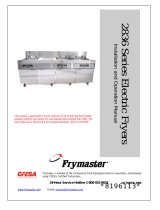
2-2
DANGER
Do not attach an apron drainboard to a single fryer. The fryer may become unstable,
tip over, and cause injury. The appliance area must be kept free and clear of
combustible material at all times.
NATIONAL CODE REQUIREMENTS
The type of gas for which the fryer is equipped is marked on the data plate attached to the inside of
the fryer door. Connect a fryer marked “NAT” only to natural gas, those marked “PRO” only to
propane gas, and those marked “MFG” only to manufactured gas.
When installing this equipment in the UNITED STATES, the installation must conform to the latest
edition of the National Fuel Gas Code, ANSI Z223.1. In CANADA, installation must conform to
the latest edition of Standard CAN-/GCA-B149.1 or .2, “Installation Codes for Gas Burning
Appliances & Equipment”. In addition to the applicable national code or standard, installation must
also be in accordance with any local codes for the area in which the equipment is installed.
In AUSTRALIA, this appliance must be installed by an authorized person, in accordance with the
manufacture’s instructions, local gas regulations, and requirements of AA601, “Installation
Requirements for Gas Burning Appliances”.
Installation shall be made with a gas connector that complies with national and local codes. In the
UNITED STATES, the applicable code is ANSI Z21.69 with Addenda, “Standard for Connectors
for Movable Gas Appliances”. Quick-Disconnect devices, if used, shall likewise comply with
national and local codes. In the UNITED STATES, the code is ANSI Z21.41, “Standard for Quick-
Disconnect Devices for Use with Gas Fuel”.
2.2 Caster/Leg Installation
Depending upon the specific configuration ordered, your fryer may have been shipped without
installed casters or legs. If casters or legs are installed, you may skip this section and proceed to
Section 2.3, Pre-Connection Preparations. Fryers must have casters or legs. Fryers cannot be curb
mounted.
Install the casters/legs in accordance with the instructions included in your accessory package.
2.3 Pre-Connection Preparations
DANGER
Do not connect fryer to gas supply before completing each step
in this section.
After the fryer has been positioned under the fry station exhaust hood, ensure the following has been
accomplished:
1. Adequate means must be provided to limit the movement of fryers without depending upon the
gas line connections. If a flexible gas hose is used, a restraining cable must be connected at all




























